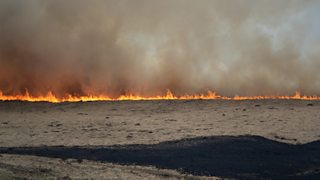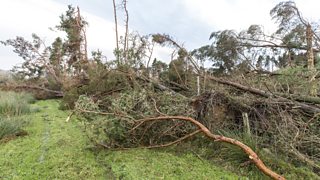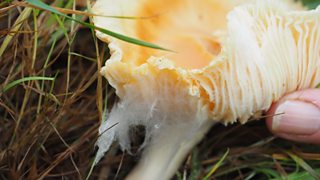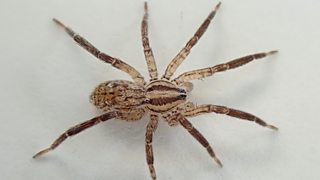From Ben McCarthy, Head of Nature Conservation and Restoration Ecology at the National Trust
Reflecting on last year’s weather, while it might feel as though it was fairly benign compared to previous years of extreme heat and floods, we found that it was bookended by two catastrophic events in particular.

Fire on Marsden Moor on 26 April 2021 by Victoria Holland
Natural disasters strike
In April, a mile long wildfire tore through Marsden Moor, in Yorkshire reducing swathes of land to smouldering embers.
Then in November, storm Arwen toppled tens of thousands of trees, including many ancient specimens, and decimating homes for wildlife in the blink of an eye. The latter left some of my colleagues – many of which have cared for these landscapes for decades – in floods of tears such is the emotional connection to these special places.
On top of this we have had cliff falls and localised flooding, all reminding us how fragile our relationship is with these remarkable places and once again really hitting home the urgency with which we need to tackle the climate crisis.
As well as dealing with extreme weather, our teams on the ground are also having to fight against increased severity in tree disease especially the effects of ash dieback.

Widespread devastation caused by storm Arwen at Wallington in Northumberland by Annapurna Mellor
Wildlife winners and losers
With the changing climate, we are seeing more winners and losers in the natural world and greater wildlife displacement.
Last year’s weather conditions with the cool, dry spring and cold, wet May suited wildflowers like orchids particularly well, but in contrast butterfly numbers were down – 60 per cent lower than 2020.
The chilly April and May’s rain and gales led to a very poor nesting season for many species of birds with a particularly topsy turvy year for seabirds like terns.

Arctic tern at Long Nanny in Northumberland by Tim Robinson, NT Images
The record number of late frosts in April and into late May in some parts of the country damaged apple blossom and the subsequent apple harvest particularly in northern parts of England and Northern Ireland.
But, it was a bumper year for grassland fungi, especially waxcaps due to a warm, damp autumn with little or no frost, with some rare or unusual species found in new places.
Fungi are changing their behaviour as the climate changes. Some species are fruiting earlier and others later, and some autumn species have started to appear in spring too.

Meadow waxcap with spores by John Newbould
New species sightings
New species were spotted at some of our sites for the first time including the critically endangered spider Zora silvestris which was discovered at Clumber Park confirming that the heathland here is one of the charity’s top spider sites.
The endangered Norfolk hawker dragonfly appeared at the Wimpole Estate in Cambridgeshire, and the Southern migrant hawker dragonfly recorded at two areas on the Golden Cap Estate in Dorset for the first time.

Zora silvestris spider first spotted at Clumber Park in October 2021 by Tylan Berry
Helping nature and tackling the climate crisis
Over the last six years, we have been ramping up our fight against the nature and climate crises and crucially, working with other major landowners like never before.
Projects like England’s first ‘Super’ National Nature Reserve, created in 2020 at Purbeck, Dorset, illustrate how powerful conservation of our landscapes and the protection of nature can be when partners come together to join segments of land together and to make homes for nature.
The National Trust and others are working at speed to create more diverse landscape and countryside to attract a wide range of wildlife – and allowing species to ‘move’ if they need to. We are preparing for warmer weather by planting plants and trees that are more resilient to disease and able to withstand periods of low or no rainfall.
These are just some of the challenges we face, and we are preparing for the change that we know is coming due to rising temperatures. We know the journey will be a bumpy one, but only that by working together we can create more resilient new homes for wildlife and help heal climate harm.
